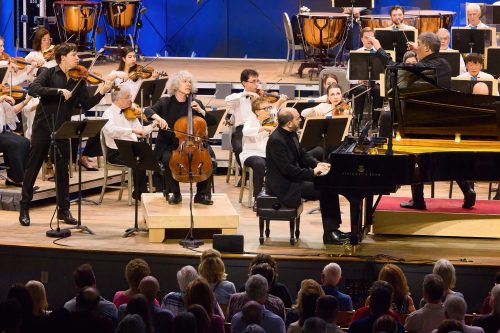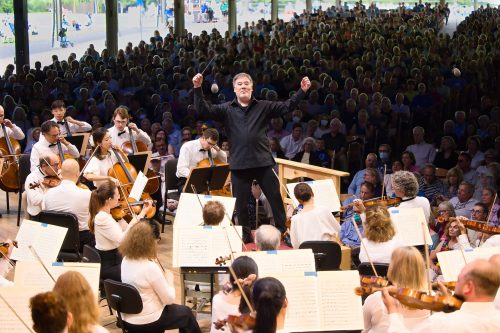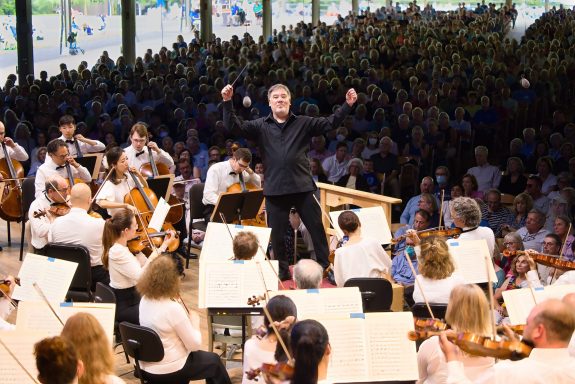 United States Tanglewood Festival 2024 [10] – Beethoven: Kirill Gerstein (piano), Joshua Bell (violin), Steven Isserlis (cello), Boston Symphony Orchestra / Alan Gilbert (conductor). Koussevitzky Shed, Lenox, 4.8.2024. (CSa)
United States Tanglewood Festival 2024 [10] – Beethoven: Kirill Gerstein (piano), Joshua Bell (violin), Steven Isserlis (cello), Boston Symphony Orchestra / Alan Gilbert (conductor). Koussevitzky Shed, Lenox, 4.8.2024. (CSa)

Beethoven – Concerto in C for piano, violin and cello, Op.56; Symphony No.4 in B-flat, Op.60
Regal, imperious, even grandiloquent are adjectives sometimes used by musicians and musicologists to describe Beethoven’s Triple Concerto. Indeed, some argue that this work, completed in 1804 when Beethoven was in his early 30s isn’t really a concerto at all, but, as The Guardian’s Tom Service puts it, ‘an amplified piano trio, with the orchestra beefing up the textures but often reduced to no more than generic accompaniment.’ Composed for his 16-year-old pupil and patron Archduke Rudolf of Austria – himself a keen amateur pianist- the work’s emphasis is on a collective conversation between piano, violin and cello, with no real dialogue between the instrumentalists and the orchestra or so it is claimed. How rewarding therefore, to hear a performance last week at Tanglewood in which a pared-down Boston Symphony Orchestra under the deft baton of Alan Gilbert fully engaged with a star-studded trio comprising pianist Kirill Gerstein, violinist Joshua Bell and cellist Steven Isserlis. The opening orchestral Allegro at first almost imperceptible, then swelling with exhilarating grandeur, served as a slow and stately introduction to the three solo instruments. Isserlis’s vibrant cello (the gut stringed 1726 ‘Marquis de Corberon’ Stradivarius) parried sweetly with the honeyed tone of Bell’s violin (also a Strad but manufactured thirteen years earlier in 1713). Their intertwined melody was then gently bolstered by Gerstein’s soft-grained pianism on an open-lidded Steinway. The result was a joyous and finely balanced tripartite exchange in which no single voice dominated, supported in perfect partnership by the orchestra. The second movement Largo featured a fervent duet between violin and cello – a passionate interchange by the supple, body-gesturing Bell and Isserlis, a halo of silver curls tossing with each turn of his head. The ever-sensitive Gerstein accompanied thoughtfully throughout. Moving seamlessly into the final Rondo, a sprightly polonaise, players and orchestra joined together equally and evenly in a thrilling, irrepressible dance.

Beethoven’s classical and compact Fourth Symphony made up the second half of the programme. It was composed two years after the Triple Concerto, in 1806. The musicologist Charles Groves rather unfairly declared that it stood between Beethoven’s heroic ‘Eroica’ Third Symphony, and his epic Fifth ‘like a slender Greek maiden between two Norse giants.’. Despite differences in scale and emotional intensity, the Fourth is indubitably a work of life-affirming genius and represents the composer, who was at that time struggling with impending deafness, at his brightest and most optimistic. Gilbert, releasing an infectious energy, took the work at a brisk pace. The performance, full of zest and exuberance, was always sharply focused and finely detailed – qualities perhaps easier to achieve with an orchestra authentically reduced in size. After an eerie, purring introductory Adagio, Gilbert released the players’ brakes, so to speak, permitting the orchestra to lurch forward in the Allegro vivace, like a racing car at full throttle. Even in the slow second movement, Gilbert ensured that the Haydnesque ticking clock theme, was tightly coiled and full of menacing humour. The Adagio was followed by a sparklingly crisp and joke-filled third movement, full of surprise off-beat accents and syncopated rhythms. A febrile final Allegro distinguished by taut strings and tightly coordinated woodwind and horns brought the symphony to a conclusion. A fittingly sunny end to an overcast Tanglewood afternoon.
Chris Sallon
